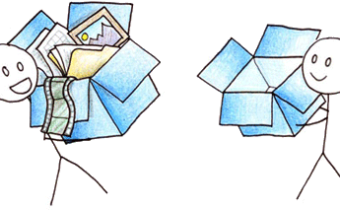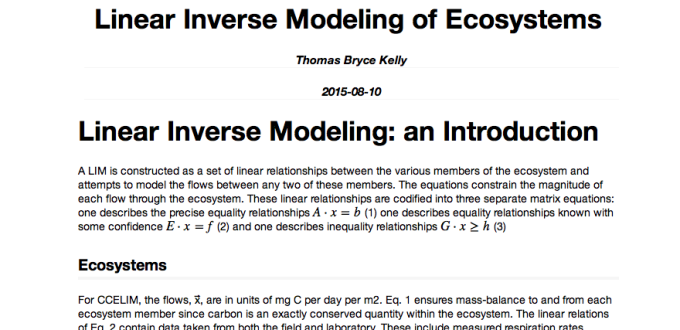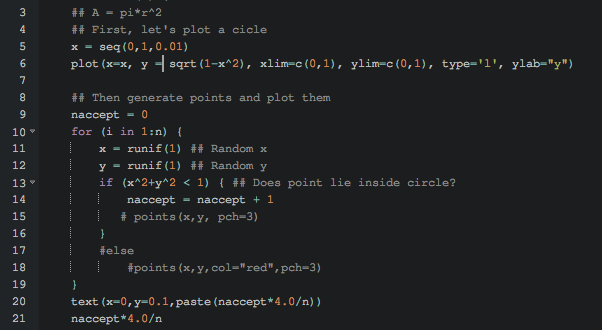When advising students about their career goals, paths forward, and expectations; I often recommend that they consider learning a program language. While the language itself depends on the goals and background of the person, being able to work directly with data is powerful. Today’s project is a good example of just such a case. A […]
Category: Technology
Lateral Transport and Connectivity in the GoM
To test hypotheses and to characterize lateral processes, there is perhaps no better region than the Gulf of Mexico; for it’s small size and it’s quick surface currents (both relative to ocean basins) are coupled to strong spatial gradients in nutrient inventories, Chlorophyll concentrations, and biomass. This connectivity can be best seen through a series […]
Programming for the rest of us: Introducing a new R package to help solve problems
As a self trained, informal, fly by the seat of my pants programmer, I am hardly the “best” person to give advice about teaching other how to program. I have no formal background in computer science and have never had anyone teach me to program, it’s just been something that I’ve played around in by […]
Faster Gridding in R
So all oceanographers are familiar with the results of gridding, even if they are not so familiar with the process. Gridding is, in general, any method that will take observations and output interpolated (and sometimes extrapolated) data that is placed onto a regular, well-behaving grid. Below is a simple illustration of just such a process […]
Call me Ishmael: computers, the sea and the stars
While ancient and modern mariners alike look up to the stars for direction, oceanographers look to the sea. Our research in particular involves moving with the water wherever it may happen to take us since we want to measure how a patch of water develops and changes over time. On my latest cruise I found […]
For lack of a better word: Clumpiness
We perceive randomness every day whether it’s the shape that clouds take or the number of red lights we face during our commute, so it is not surprising that our intuition is well suited to some of these phenomena. The human mind attempts to bring order to the chaos as it were, and in doing […]
Plex media server
As someone with a lot of digital content including movies, TV shows and music, I’ve always been on the lookout for new and useful ways to get the media where I want it. Previously I’ve used a Raspberry Pi computer with KODI to organize and play my media on my main TV, but I was […]
Daily Dose: Checkout Dropbox’s new Feature
Dropbox has a new beta feature out that I think you should know about. While Dropbox is well known as a go-to backup and file sharing platform, few would realize that they’re posed to become much more integrated into our digital world. The trademark feature, and primary reason for the ubiquity within their market, is the […]
First Impressions of Shiny, an R Package
Today I wanted to try something new; so instead of discussing a project, let’s briefly take a look at an R Package I’ve recently discovered. Before we being let me just mention that I realize not everyone uses R or have even used it before, instead my focus here will be on the technology, innovation, […]
The benefits of interdisciplinarity: residence time
The so-called residence time of a system is both an immensely useful and highly intuitive conception which provides a relevant timescale for processes. For example, the residence time of nutrients flowing into a pond would be the average ‘lifetime’ of the nutrients before being taking up by the pond creatures. If it is a small […]
Julia Language for Scientists
Today I wanted to take a moment and introduce a programming language to my friends and colleagues. While certainly not a common topic, I do so because I believe that it is well worth your time. Rather than trying to get non-programmers into a language, I write this for the already initiated such as those […]
Getting Started in 3D Printing
As someone who enjoys working on projects and tinkering with everything from computer systems to welders, I’ve always had a passive interest in 3d printing technology; yet I never seriously considered getting a one for myself. 3d printers work in much the same way a normal printer does, except instead of ejecting ink out of the […]
Interpolating Bathymetry to Unstructured Mesh
A few weeks (perhaps months) ago I introduced the side project that I am involved with (here) whereby our aim is to develop a hydrographic model for Apalachicola Bay, Fl. Today I wanted to provide an update for that project while also sharing some interesting problems that we’ve had to work around. To see the […]
Sediment Traps: Historical Trends and the Promise of Inovation
[NB: The first entry in this series was published here, Introduction to Sediment Traps, which covers the motivation, use and issues of sediment traps.] Although validation of the data was lacking, sediment traps (or sedimentation traps as they were once called) were being used by the 1970s in the study of lakes (Davison et al., 1982; […]
Common Image Formats Explained
After a recent conversation with a friend about photography and digital images, there seems to be many unanswered questions out there regarding the wide variety of image formats which have become commonplace in our lives. A few months ago I wrote a short article on HDR Photography (link) since so many people were asking questions […]
Analyzing YSI data through clustering
Update 10/13/15 – Minor improvements to code and an update to the latest findings. CTD data (conductivity, temperature and depth) from a YSI provides a quick and methodologically simple way to estimate the current water column state by, literally, dropping an instrument off the side of a boat. During each deployment the YSI records the […]
The Future of R
On a day to day basis, I use the R programing language more than any other language (e.g Python, Java, Fortran, Matlab…), and there is a good reason for it: R excels at the sort of work I do. It has been extremely well suited to my modeling work, especially when going to analyze the […]
Markov Chain Monte Carlo: A Practical Introduction
Markov Chain Monte Carlo simulation sounds, admittedly, like a method better left to professional practitioners and the like; but please don’t let the esoteric name fool you. MCMC, as we like to call is, is a powerful yet deceptively simple technique that can be useful in problems ranging throughout science and engineering. Since this promises […]
Finalizing my research, the CCELIM model, in R
For the past 6 months I’ve been working on an inverse modeling project as a ‘starter’ graduate project, and today I am announcing that I can see the light at the end of the tunnel. While there is certainly more work ahead, especially with regards to the manuscript, the model and the code are just […]
Which Witch is Which
This post is an elaboration of an iRKernel Notebook which can be found at http://misc.tkelly.org/Which_Witch.html. For a previous article on the iPython Notebook, see here. Every programming language comes pre-packaged with certain basic functions, or methods, that are considered standard. These generally include methods for sorting objects, conversions between basic types (e.g. integer $\leftrightarrow$ float […]
Making R your own: Scripting & Tweeting
Previously I have spoken on the merits of the R programming language (here) and alluded to its place in my research (here)[1], so today I thought it was about time to share how I approach using R in my research. R–just like any other tool–needs to be leveraged in such a way that the use […]
Optimizing R Code in my Model
Recently I have been talking a fair bit about my inverse modeling work, so now that it’s summer I finally have time to clean up the code base. Now that the code is working fairly well and offers all of the main features that I can think of, the goal is to get it running […]
Remote Sensing Part 2
In a previous article I described a technique to determine the dye concentration from drone images, and I hope it sounded like a reasonable plan. Nevertheless, this plan did go ary when less than ideal conditions arose and the results got jumbled with the imperfections of the real world. So to make amends, I will […]
Working with HYCOM
So far this week I’ve been focusing my energies on getting the Hybrid Coordinate Ocean Model (HYCOM) up and running on my computer. For those of you who don’t know what HYCOM is a modeling platform sponsored by the National Ocean Partnership Program which includes–among others–FSU. Simply put, the HYCOM platform is a powerful ocean-atmospheric […]
How Twitter Improved my Ecological Model
For a last couple weeks I’ve been working on a marine ecosystem model using a technique called Inverse Modeling[ref]I’ll be sure to do a writeup on what Inverse Modeling is and what makes it interesting in the future.[/ref]; and while there’s been lots of progress, I’m starting to get to the point where the model takes some […]
Announcing my new Misc directory
I’ve started yet another endeavor to get my work organized into some system–or rather system of systems as it most often turns out to be. Recently the solutions for which I’m looking to find have to solve a problem that most people have and don’t realize. Most of my files and works were done by […]
Finite Difference Implementation
For my numerical methods course–a course centered around the tools and techniques used in modeling ocean systems–we have been tasked with programing a 1D model of a differential equation with simple initial conditions. Our implementation has to be in Fortran, a computer language with a long history, which has been a bit of a learning […]
Ray Tracing, or Why I bite off more than I can chew
I’ve spent countless hours and a considerable about of energy on getting my ray tracer up and running, and this is what I have achieved: While it may look like modern art[ref]Actually, since art exists independent of intent and as a result of a observer-entity interaction, this picture would be “art”. Whether it is modern […]
Paper of Note: Fast, Minimum Storage Ray-Triangle Intersection
Introduction Raytracing is modern computer graphics technique used to render life-like images for videos and animations. While it’s a relatively modern technique–coinciding with the birth of digital modeling–the inspiration for the methods can be traced back to ancient Greece. While some Greeks truly believed that our eye’s emit the ability to see and not that our […]
If I were a farmer…
While checking out the latest headlines and otherwise perusing the PLOSONE site in search of some new and interesting research, I came across a meta-analysis that sounded interesting. With the provocative title of ‘A Meta-Analysis of the Impacts of Genetically Modified Crops’ [ref]Klumper and Qaim, A Meta-Analysis of the Impacts of Genetically Modified Crops. PLoS ONE 9(11): […]











